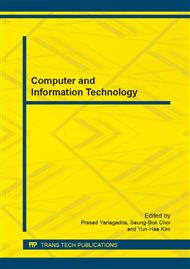p.636
p.640
p.644
p.651
p.655
p.661
p.667
p.672
p.676
Binocular Stereo Matching Method Based on Parallax Waveform Analysis and Conjoint Measurement of Saliency Map
Abstract:
In this paper, we propose a coarse-fine matching algorithm based on parallax waveform analysis and conjoint measurement, which aims at performing the binocular stereo matching in natural scene. For the reason that human only notices the most saliency parts in image, we first extract the saliency areas of the two images, which suppresses the interference of background and reduces the computation cost. According to the saliency map, a global algorithm based on parallax waveform analysis is proposed to achieve the best coarse matching. On this basis, the fine matching is completed by analyzing the local features with the conjoint measurement of SAD and SSIM, which further improves the accuracy in binocular stereo matching. The performance of our algorithm is well demonstrated by experiments.
Info:
Periodical:
Pages:
655-660
Citation:
Online since:
February 2014
Authors:
Price:
Сopyright:
© 2014 Trans Tech Publications Ltd. All Rights Reserved
Share:
Citation:


